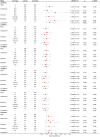RARB genetic variants might contribute to the risk of chronic obstructive pulmonary disease based on a case-control study
- PMID: 39723714
- PMCID: PMC11703482
- DOI: 10.1080/07853890.2024.2445195
RARB genetic variants might contribute to the risk of chronic obstructive pulmonary disease based on a case-control study
Abstract
Background: Chronic obstructive pulmonary disease (COPD) is a progressive respiratory disease that severely impairs patients' respiratory function and quality of life. RARB is involved in COPD progression by affecting inflammatory reactions, cell proliferation, and apoptosis. The impact of single nucleotide polymorphisms (SNPs) within RARB on COPD susceptibility remains unclear. Here, we aimed to evaluate the association between RARB SNPs and COPD risk.
Methods: A total of 270 COPD patients and 271 healthy controls were enrolled. The MassARRAY iPLEX platform tested the genotype of the SNPs. The association was analyzed using logistic regression analysis. The false-positive report probability (FPRP) analysis was performed to validate the significant findings. The relationship between SNPs and RARB expression was evaluated using the GTEx database.
Results: Our study found a significant association between rs6799734 and COPD susceptibility (OR 1.88, p = 0.008, p (FDR) = 0.047). The stratified analysis revealed that this association was particularly pronounced among individuals aged ≤ 71 years (OR 2.34, p = 0.011, p (FDR) = 0.045), males (OR 2.60, p = 0.002, p (FDR) = 0.013), those with a BMI ≥ 24 (OR 3.95, p = 0.018, p (FDR) = 0.108), and smokers (OR 2.48, p = 0.020, p (FDR) = 0.120). Additionally, rs1286641 and rs1881706 showed significant associations with COPD risk in females and smokers. These associations were further validated by FPRP analysis. Preliminary mechanism studies indicated that rs1286641 and rs1881706 were related to RARB expression.
Conclusion: Our findings suggest a potential role of RARB SNPs in influencing COPD risk.
Keywords: Chronic obstructive pulmonary disease; RARB; single nucleotide polymorphisms; susceptibility.
Conflict of interest statement
No potential conflict of interest was reported by the author(s).
Figures



References
MeSH terms
LinkOut - more resources
Full Text Sources
Other Literature Sources
Medical
